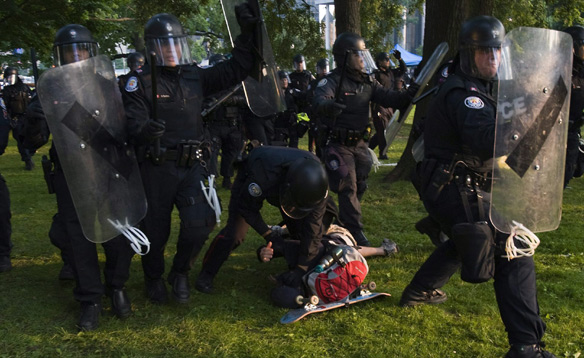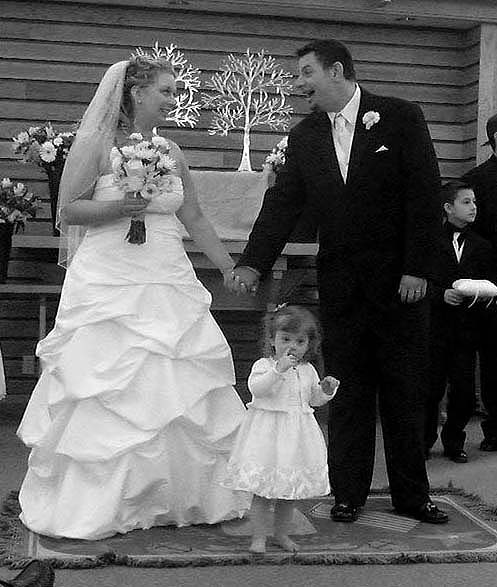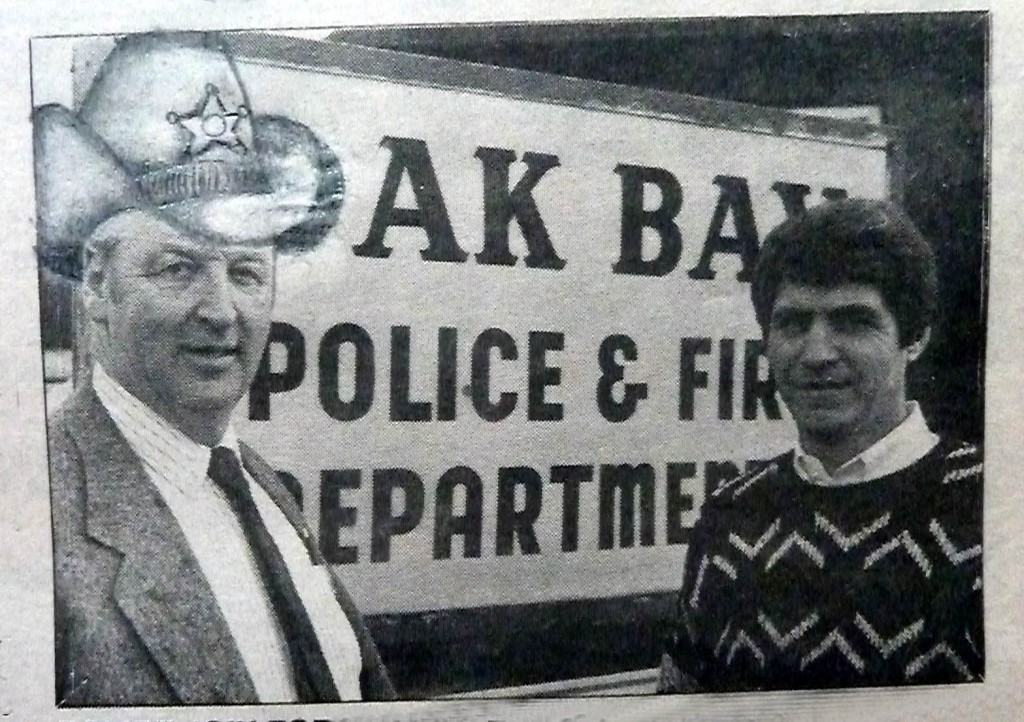Border Security Gone Crazy
Note
This week the National Post, as well as many other media outlets, is carrying a series of articles and stories related September 11 2001. While 911 was monumental tragedy in terms of lives lost and families torn apart, the damage done over the past ten years by governments, particularly in the USA who have lead the world, is much greater both in terms of lives lost and families destroyed. Beyond that, the invasion of privacy by security agencies, including our very own, is unprecedented. 911 was no D Day, VE or VJ Day. It was a criminal act that deserved only to be treated as such. The following editorial touchs on only a few aspects of the changes that have taken place.
(799)
Preserving Our Civil Liberties
Preserving Our Civil Liberties
July 7, 2011: Closure of the British Tabloid “News of the World”
The demise of the 168-year-old British paper that held a readership of nearly three million, all over a ‘mobile phone – internet hacking’ scandal, was a bit of overkill when compared to the attack on our civil liberties by our own governments over the past decade. In the case of News of the World a high price will now be paid by the thousands of dedicated, honest workers all because of a few dishonest people at high levels, including the owner’s son, James Murdock.
It is reported Murdock closed the paper because he wanted to protect his reputation (and that of his father, Rupert) as well “protecting” other money making schemes he currently has on the table. I have little sympathy for Murdock and for those who cheat and scheme in order to make an extra dollar, what hurts is seeing all those jobs taken away from thousands of honest workers who toiled at the paper.
While the allegations against a few reporters and senior administrators at World News was serious and needed to be addressed, the transgressions were positively minor compared to the widespread intrusions on civil liberties conducted by various government security organziations around the world.
(521)
Water for Elephants (Release: April 2011)
It was a discouraging time deep in the depression of the 1930s when men were riding the rails in search of work and their next meal. Labour laws were non-existent and abuse of the less fortunate a reality of every day life. A naive young man, Jacob ((Robert Pattison), was about to graduate from Cornel Veterinary School when his world was suddenly turned up side down.
He fleed school and joined a second rate circus run by an unscrupulous and abusive owner, August (Christopher Waltz), who was married to the seductive centre ring performer Marlena (Reese Witherspoon). Events spun out of control as the circus crossed the country and Jacob found himself in a love triangle fighting not only for his own life but also for the lives of the animals in his charge and some of the carnies who had befriended him.
The show engagingly begins and ends by means of flashbacks with Hal Holbrook playing ‘Old Jacob’ in a manner that brings into close focus the ephemeral nature of love, life, birth and death.
Lynn and I very much enjoyed this 120 minute movie and gave it four thumbs up. Without reservation we encourage you to put this movie on your ‘must see’ list.
Cheers
Harold
(457)
The Best Laid Plans (1)
Jack Tackles the Giants on the Beanstalk

Do you remember ever having the feeling your world has just been turned upside down? Perhaps you were nearing 50 when your wife came home and calmly stated: “Guess what honey, I’m pregnant?” Or, in the worst case, it was not your wife it was that less than full time girl friend (not as uncommon as you might think). In either case it was a game changer. I experienced the former but, thanks to my chaste behaviour, never the latter.
In another case perhaps it was your boss who came in and said: “Sorry, but due to the recession we are cutting back, ah, but not to worry, you are a good worker so you should have no trouble finding a new job!” Bummer dude! Perhaps we are about to experience a similar type ‘game changer’ on the national political scene.
Having closely followed the campaign over the past few weeks I was struck by how mundane everything seemed to be evolving when, suddenly, late last week, the folks in Quebec decided they might just want to try something different. No, they did not start importing tons of the best BC Bud (not a bad idea through), they just found a new religion called NDP. It is now possible the Bloc might soon be a footnote in history. Can’t say I would be sorry to see them finally exit stage left.
everything seemed to be evolving when, suddenly, late last week, the folks in Quebec decided they might just want to try something different. No, they did not start importing tons of the best BC Bud (not a bad idea through), they just found a new religion called NDP. It is now possible the Bloc might soon be a footnote in history. Can’t say I would be sorry to see them finally exit stage left.
Now what about poor Jack? How would you like to have the whole La Belle Province riding on your coat tails? All I can say is he had better have a strong ‘constitution’. After the election he could be leading a group of neophyte politicians, including a number of young student candidates with no political background, into the blood sport that is Ottawa. Perhaps that is just what we need in opposition, a bunch of young idealists with nothing to lose.
From my perspective, it would be an excellent outcome – a Harper minority (140 seats), NDP (90 seats, including a major position in Quebec), Liberal (60 seats) and Bloc (15), Independent (2) and Greens (1) as somebody has gotta finally throw poor Lizbeth a bone. Taken in combination it just might be the tonic we need to shake things up on the Federal scene. Just as  the Conservatives moved to coalesce the right a few years back, the left needs an ‘earth shaker’ to cause them to put the left leaning house in order.
the Conservatives moved to coalesce the right a few years back, the left needs an ‘earth shaker’ to cause them to put the left leaning house in order.
Given the heavy turnout in the advance polls and if the current poll trends portend future seat results, we might just go to bed on May 2, 2011 with a game-changing Parliament.
Cheers
(Harold is a card carrying Liberal but willing to look at alternatives)
1For a good chuckle on this very subject read “The Best Laid Plans” by Terry Fallis (McLellan Books, 2008), winner of the CBC Canada Reads Award, 2011. The book takes a peek inside the back rooms of national political parties where a crusty old Scot, Angus McClintock, is suddenly and unwillingly thrust into the fray. He quickly becomes a media darling and throws every party, including his own Liberals, into disarray. Just as has every movie and TV series hero that challenged the status quo found a cult following, so does the reluctant Angus McClintock.
(377)
Cornucopia Traditions – Alive and Well in Victoria
Traditions
Jamie and Kia Charko
April 16, 2011
The matt upon which Jamie and Kia were married has been in the Simonsen family for over 300 years. During this time dozens of family members have been married. Here their daughter, Liala, shares in the celebration.
Cornucopia Cake: The Cornucopia (korn-yoo-KO-pee-uh) symbol stretches across many cultures and peoples from Ancient Greece to modern day. That it is part of many wedding celebrations is only natural.
(485)
My New R.I.M. Blackberry for Seniors
Harold doing some in-store testing of the new Blackberry Playbook for Seniors
It was chilly with a dusting of snow when I left home at 2:00 am yesterday to join the line a Future Shop to get my new Research in Motion Blackberry “Playbook for Seniors’. My trusty Tim Horton’s super mug in hand – a double, double, triple, triple with a couple of shots of Kahlua (and small bottle in my backpack) – helped to ward off the cold and calm the knot in the pit of my stomach. Would I be too late? Not to worry, by 9:30 am I was inside and the supplies looked to last.
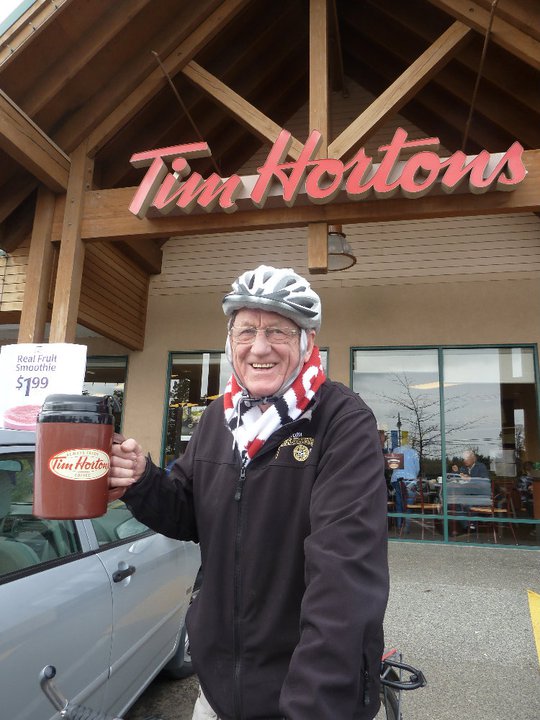
Photo: Harold bikes our for his usual morning cuppa at Tim Horton’s. The two litre cup cuts down on refills.
My first surprise was the size. The new Seniors Edition was at least 32 X 55 cm (12 X 22 inches) but with a high definition screen and large print (even at 36-40 pt. you can still get a full page on the screen) it is certainly easy to read. You know, you can actually enlarge words and flip pages with just the flick of a finger? Amazing!
Now, a word about price! At $700 (2 gb storage) a crack, plus $200 for the tax and extended guarantee, it is well within the means of most seniors. Just don’t forget to factor in an average $400 per month for Apps, internet access, download fees, book purchases, etc. so you don’t over extend yourself (1). My bets – move over Apple – this new RIM Seniors Edition Playbook is about to take the market by storm.
The only real challenge I found was trying to fit the device in my jacket or briefcase and I am wondering whether getting through airport security is going to be a problem. Perhaps, in the future, RIM will consider a folding model.
Congratulations to Jim Balsille and Mike Lazaridis, you and your RIM Team from Waterloo have made Canada proud – another first for Canadian Technology that is on a level with the Canada Arm. From this Canadian Senior – two thumbs up.
Harold McNeill
Victoria, BC
(1) For BES (Blackberry Enterprise Server) there is connectivity from that BES to RIM’s NOC, and that’s an extra charge. This is done via the SRP (Service Routing Protocol). Each BES has a unique SRP, just like our handhelds have a unique PIN. BES has better guaranteed service versus a BIS plan. On a BES you get way more functionality than BIS and you get more security, etc. These are matters are near and dear to most seniors.
(My young friend Riyad at Future Shop, passed along these helpful tidbits)
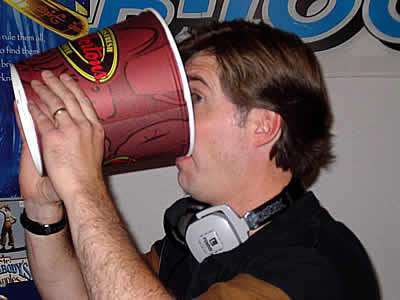
Staff at both Future Shop and Staples had to catch a coffee on the run as business was so brisk.

IPad vs Blackberry: While IPad has a jump on the market, the Blackberry Seniors model is likely to become a very big hit with the boomers who are just now entering those mellow years. My guess is the larger Blackberry will outsell the IPad by a factor of two or three.
(529)
PAX Canadiana
PAX Canadiana: In the 20th Century the term PAX Americana came to indicate the pre-eminent military and economic position of the United States in relation to other nations, just as PAX Britannia was used the 19th Century (Wikipedia background). In the 21st Century, Canada will eclipse the United States and PAX Canadiana could become a reality. This article provides a satirical look at the alternate path we may choose to follow.
February 10, 2016 Update
1. Corporate Taxes
What got m thinking of this was the whole issue of “Corporate Tax Reductions.” With our Federal rates approaching 15%1, I checked the G20 major economies and found none below 25%. Then I checked on Ireland – poor little Ireland (not a G20 by the way) – they went bankrupt – just when they achieved a Corporate Tax rate of 12.5%, lowest in the EU and lower than the rest of the world, save for a few OPEC countries.
 This happened even after Google and dozens of big companies moved to Ireland to catch a piece of that generous corporate tax pie. As supply-side economists, trickle-down theorists3 and deregulators predicted, unemployment shrank to near zero and “things were booming”. Ireland was sitting at the top of the EU financial world. Then bang – the crash – banks folded and massive debt took the country down. The prescription for a sound financial future sounded great but the patient was dying. On their knees, they went to their EU partners for a bailout.
This happened even after Google and dozens of big companies moved to Ireland to catch a piece of that generous corporate tax pie. As supply-side economists, trickle-down theorists3 and deregulators predicted, unemployment shrank to near zero and “things were booming”. Ireland was sitting at the top of the EU financial world. Then bang – the crash – banks folded and massive debt took the country down. The prescription for a sound financial future sounded great but the patient was dying. On their knees, they went to their EU partners for a bailout.
Could this happen in Canada? With a projected national debt exceeding half a trillion, with further tax cuts promised and cash being handed out for everything but the kitchen sink (well that too if the Conservatives reconstitute their billion-dollar “home improvement program”) it could happen. We might very well be headed down the same path as Ireland and our good neighbour, the USA, whose move to supply-side economics and deregulation over the past several decades lead to the worst economic meltdown they have ever experienced. They are now printing money so fast many of their presses have overheated and, if the rumors are correct, may have broken down4.
Then, to my great relief, two newspaper articles appeared – one in the National Post, the other in the Globe and Mail. The first was a three-page spread in the Post entitled: “Global Warming – Bring it On” and, the second, in the Globe, “Republicans Urge New Pipelines.” Republicans? Republicans? It was no surprise to see the National Post calling ‘Global Warming’ a “good thing”, but US Senate Republicans calling for help from that great white, socialist enclave called Canada; that was when the loonie (our new penny) finally dropped.
Footnotes:
1 Between 2000 and 2006, the Liberals reduced the Corporate Tax Rate from 29% to 21%. From 2006 to 2011 the Conservatives further reduced to 16.5%. The Conservatives indicate a further reduction to 15% is needed to boost investment and reduce unemployment. Now the question, if a reduction from 29% to 15% was needed to boost investment and decrease unemployment, would not a further reduction from 15% to 0% be even better? We might wish to ask: “For whom?”
3 Referencing “trickle-down theory” humorist Will Rogers, said during the Great Depression (known as the “Dirty Thirties”): “The money was all appropriated for the top in hopes that it would trickle down to the needy.” (partially Wikipedia)
4 Unless the US Congress takes drastic steps they will be dead broke and shutting down parts of government when they reach their debt limit. A debt default by the USA will have worldwide implications.
(15344)
International Pursuit of a Felon
Photo (Oak Bay Star): Detective Sergeant Al Campbell (left) and FBI Agent, Bob Hanis from South Bend, Indiana.
January 15, 2012:For a recent similar case in Canada involving an estimated one billion in marihuana, read the National Post article: A Great Movie Script
A Soft Landing in Canada
Do not get on the FBI’s Most Wanted list, or have your mugshot broadcast around the world as that could be the beginning of the end of a financially rewarding career in crime. Such was the case of one young man who dared try to hide behind the Tweed Curtain in Oak Bay, British Columbia. For Constable Al Campbell it was an exciting time as he chased one of the FBI’s Most Wanted through the streets of Oak Bay. The story began many months before in Indiana…
Unsolved Mysteries – Joins the Chase
In 1987 Robert Stack began hosting a new TV Series, Unsolved Mysteries, that soon became a perennial favourite. In addition to two or three feature articles each week, the hour-long 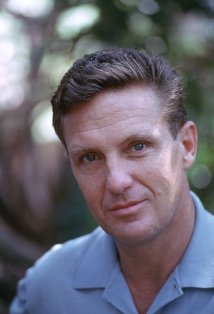 production profiled persons on the “FBI Most Wanted” list. On January 9, 1991, the program included two international drug traffickers – Thomas Paul Hickey and William James McCarthy, both men then in their early thirties.
production profiled persons on the “FBI Most Wanted” list. On January 9, 1991, the program included two international drug traffickers – Thomas Paul Hickey and William James McCarthy, both men then in their early thirties.
Photo: Robert Stack, who was a periodic regular host of the show through the 1980s and 90s, was better known as the handsome, no-nonsense Elliot Ness in the TV and movie series the ‘The Untouchables’.
In late 1986 Indiana State Police indicted Hickey and McCartney on forty-three counts including drug trafficking, participating in a continuing criminal enterprise, possession and conspiracy to distribute marihuana, obstruction of justice, interstate transportation in aid of racketeering and, for good measure, a charge that was the undoing of many mobsters in the ‘Untouchables’, income tax evasion.
The broad-ranging criminal enterprise built by Hickey and McCarthy from early 1979 through 1986 was spurred on by a high demand for marihuana that had developed during the ’60’s and ’70’s “hippie years” on College and University campuses across North America. In the 1980s the taste for that exotic weed soon spread to the business and professional community as college and university students, after graduation, were not about to leave behind all the perquisites of campus life. While Mary Jane was bulky to transport and distribute, Hickey and McCarthy overcame the challenge by contracting a fleet of semi-trailers to move the parcels to dozens of cities across the United States.
(4712)

